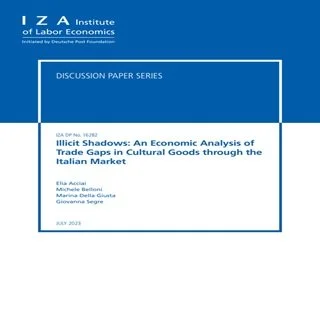By Elia Acciai, Michele Belloni, Marina Della Giusta
This paper provides evidence of a consistent gap in the value of cultural goods exported from Italy and the value declared by its trading partners in official trade statistics for the period 1994-2021 and discusses it in the context of the literature on illicit trafficking in cultural property, a phenomenon that plights a number of both developing and developed countries rich in cultural heritage. Differences between the four categories of cultural goods recorded (archaeological goods, antiquities, paintings, and sculptures) are exploited to highlight potential areas where trafficking might be expected to be larger. We construct a panel dataset to estimate a gravity model of the gap including market size, extent of trade, level of corruption and adoption of protective legislation (UNESCO and UNIDROIT) and discuss results indicating further questions to be investigated in this important and to date under researched policy area.
IZA Discussion Paper No. 16282
Bonn: IZA – Institute of Labor Economics . 2023. 18p.



